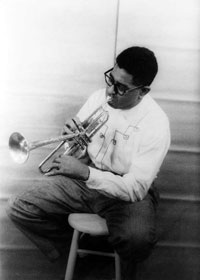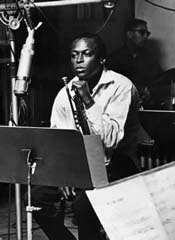
Afro-Cuban Jazz
Dizzy Gillespie is credited with having brought the polyrhythms of Afro-Cuban music to bebop. Latin band leader Mario Bauza introduced Gillespie to Chano Pozo, a renowned conga player. Together they composed "Manteca," now regarded as the first Afro-Cuban jazz composition. Several musicians would take up the infectious rhythms of Afro-Cuban jazz including Tito Puente, George Russell, and Miles Davis (on his Sketches of Spain recording).
Miles Davis: A Giant of Postwar Jazz
It is impossible to underestimate the importance of Miles Dewey Davis in jazz during the second half of the twentieth century. Davis was directly involved in the establishment of bebop, modal and cool jazz, free jazz, electric jazz, and fusion. His fifty-year career features jazz renditions of music by contemporary pop musicians such as Michael Jackson. Though he was frequently honored in his lifetime, Davis also faced tough critics, fickle audiences and personal hardships.
The Birth of Cool
In 1944 Davis moved from his home in Alton, IL to attend Juilliard School of Music in New York City. Shortly after arriving there he sought out Charlie Parker and began recording with Parker's group. Davis also connected with Gil Evans whose original compositions and arrangements merged well with the Davis' sound.
Recordings of the group began in 1949 but were not released on vinyl disc until 1957 under the title Birth of the Cool. Birth of the Cool marked a significant turning point in the sound of jazz. Not only did the ensemble have an unusual instrumentation that included french horns and a tuba, but Evans extended the harmonic language of jazz to include ambiguous harmonies and chord progressions. Davis' laidback playing style as well as his own personal demeanor of being fashionable but somewhat aloof inspired many musicians, especially those working on the West Coast.
Modal Jazz
For nearly twenty years the Evans/Davis collaboration would reconfigure jazz's sound, leading to several recordings such as Porgy and Bess and Sketches of Spain that were often criticized as something other than jazz. But Davis kept moving forward and in the late 1950s formed a quintet with John Coltrane (tenor saxophone), Red Garland (piano), Paul Chambers (double bass) and Philly Joe Jones (drums). Later John "Cannonball" Adderley would step in to create a sextet. With this ensemble, Davis returned to his bebop roots. With his insistence on playing longer and more legato phrases, he began exploring music made with modes-a set of musical scales used during the Medieval Period that was now being explored more theoretically by composer/performer George Russell. Russell began to formulate ideas on how jazz could extend its musical resources by exploring outside the traditional major/minor systems of music. One of his most gifted students was pianist Bill Evans, who was asked to join Davis' group in what is considered to be Davis' most essential recording Kind of Blue.
The first track appearing on Kind of Blue has arguably become Miles Davis' most influential recording. "So What" is an exploration of the Dorian mode based on a 32-bar blues form that alternates between only 2 chords. The piano chords played by Evans in the opening are based on chords built from stacked fourths (rather than the traditionally tonal chords built on stacked thirds). So important are these harmonies that they have been called the "So What chords" by many musicians.
♫ ![]() So What
So What
Miles Davis

Opening music of So What by Miles Davis
|
Harmonic plan of "So What" |
||
| 16 Measures | 8 measures | 8 measures |
| dm7 | e♭m7 | dm7 |





"Blues developed in the southern United States after the American Civil War (1861-65) and was largely played by Southern black men, most of whom came from the milieu of agricultural workers."






